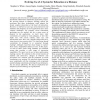Free Online Productivity Tools
i2Speak
i2Symbol
i2OCR
iTex2Img
iWeb2Print
iWeb2Shot
i2Type
iPdf2Split
iPdf2Merge
i2Bopomofo
i2Arabic
i2Style
i2Image
i2PDF
iLatex2Rtf
Sci2ools
HICSS
2000
IEEE
2000
IEEE
Evolving Use of a System for Education at a Distance
Computers and networks are increasingly able to support distributed collaborative multimedia applications. In fact, the growing interest in distance learning reflects the awareness that these technologies could support the broad, complex interaction at the heart of instruction. However, we still have a way to go; users (instructors and students) and designers of such applications face many complex challenges. For example, social conventions governing use are needed, but for a given array of features in the application, we don’t know what conventions are optimal or even adequate, or how they might vary with course content, class size, and instructional style. How will a flexible design that lets a class form its own practices fare? To what extent should conventions be designed in or promoted through training? Although researchers have begun to explore these issues, longitudinal studies are rare. In this paper, we look at these issues using Flatland, an extensible system that provides...
Biometrics | Collaborative Multimedia Applications | Complex Interaction | HICSS 2000 | Social Conventions |
| Added | 31 Jul 2010 |
| Updated | 31 Jul 2010 |
| Type | Conference |
| Year | 2000 |
| Where | HICSS |
| Authors | Stephen A. White, Anoop Gupta, Jonathan Grudin, Harry Chesley, Greg Kimberly, Elizabeth Sanocki |
Comments (0)

